Vincent Laforet’s Directing Motion workshop has done what every workshop should do – it’s challenged my current way of working and given me clarity on how I can improve my work. Less than 24 hours after the workshop, I was working differently, shooting differently and thinking differently. This might just be the best workshop for those shooting (or with an interest in shooting) motion work, ever.
For the last three months or so, I worked with Vincent to help build out and develop content for his tour. The foundation of the work began with the question, “How do you maximize audience engagement?” We tore through and broke down scenes in movies, developed motion graphics animations for new ways to look at shot analysis and tried to always come back to basic principles that were applicable across the board, regardless of experience or genre/focus area.
Nothing prepared me for what the actual workshop would look or feel like, however. What Vincent has managed to do is provide a day-long platform that couples engaging theory with practical hands-on learning experience through a number of live shoots take place throughout the day.
He's designed the workshop for anyone with any interest or experience in motion work, to feel comfortable and to come away with real learning outcomes. It starts off at a nice, steady pace and gets progressively more advanced as the day plays out, never feeling overwhelming. "Directing Motion" is an apt name for the workshop because the emphasis is both on the directing skill set (managing and leading your crew) as well as understanding the core principles of camera motion.
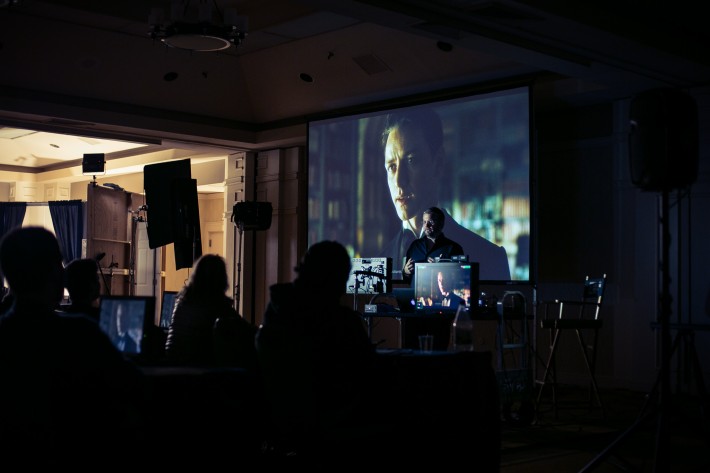
What Is Being Taught?
The daytime workshop is divided up into half a dozen key sections and followed with evening seminar.
During the day we covered:
1. Camera Movement and Language – this sets out not only the common language of camera moves, but – more importantly and definitely more interestingly – explains the psychology and effect that a camera move has on how we feel. Watching a slow zoom in on Normal Bates in Psycho suddenly makes more sense because the director is slowly trying to put us inside Bates’ head with this move. A parallax slide and counter pan in Empire of the Sun past Christian Bale's character as he pretends to be dog fighting in a wrecked fighter plane, make us feel like we are swooping through the skies within the confines of his active imagination. Every great director moves the camera in every shot with intent.
Discussion around building tension within a scene, and what to include and exclude from the frame quickly progressed into more complex montage sequencing and combination camera moves.
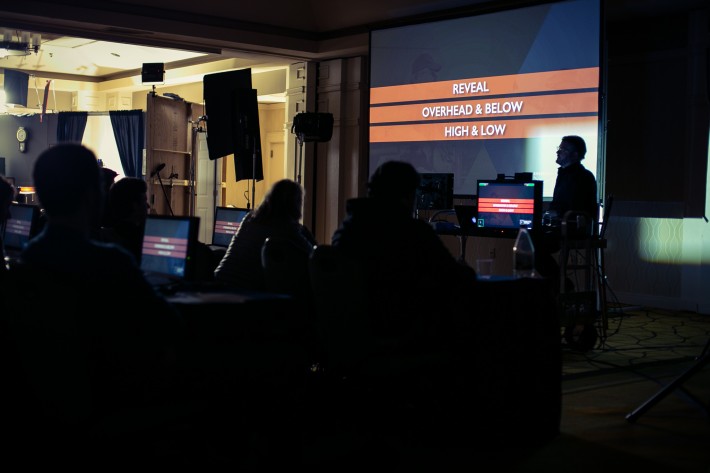
2. Live Shoot 1 – this was the first live shoot sequence. Vincent has brought more toys than you can shake a stick at, including an awesome JL Fisher dolly, a bunch of Canon C100s, a MoVI and a bunch of Kessler gear. After discussing how to "block" your actors and camera (where they start and end within a scene, how both the actors and camera moves through the scene, and why), crew members were sourced to step up to the plate for key crew roles such as DP, 1st and 2nd AC, dolly grip and boom operator. As soon as the crew were assembled it was obvious that even the most simple of moves are inherently complex. What was amazing was that people didn't really have experience with their specific roles but still pulled them off.
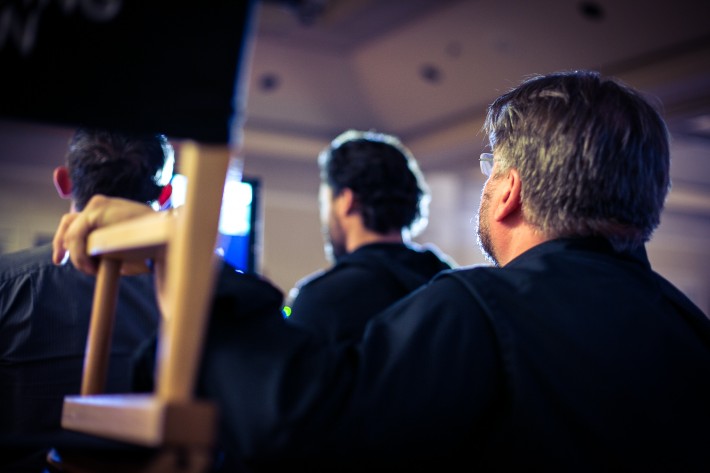 Vincent watches over the shoulder of his focus pullers on set
Vincent watches over the shoulder of his focus pullers on set3. Combining camera moves – we looked at more complex combo moves, and the use of narrative tools (storyboarding, shot lists, schedules) were looked at in prep for planning and recreating some more complex combination moves later.
More psychology of combined camera movement was then broken down. One example was the classic scene in Goodfellas where Ray Liotta’s character, Henry, wakes to find himself staring down the barrel of the gun his wife has pointed at his face. A classic POV move to build tension which transitions to a bed-level wide side when the tension is released when Henry gains control of the situation. The psychology of camera movement was incredibly fascinating to look at. Although we may have a good instinctive feel for how a camera move can make us feel, it's really important to understand why this is so we can build in our own style to this interrelationship between movement and emotion response.
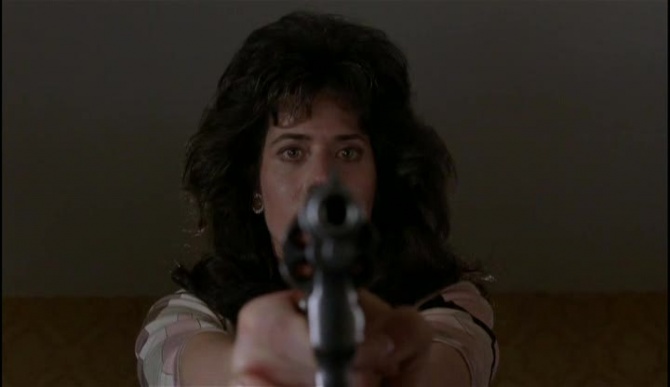
4. Coverage – Vincent likes to remind the class frequently that certain principles apply whether you are shooting a film, a commercial, a wedding, a documentary, and that’s the importance of coverage – get your establishing wides, your connective mediums and your close up detail shots.
This led into Live Shoot 2 where a really well recreated scene from Schindler’s List was acted out and shot on a set specifically built for the scene. Putting the theory into practice is invaluable when so many concepts are being discussed. Even Peter Hurley got in on the mix.
 Peter hangs up head shots for the day to hop on the JL Fisher and get to grips with directing motion.
Peter hangs up head shots for the day to hop on the JL Fisher and get to grips with directing motion. A brilliantly recreated scene from Schindler's List is shot live
A brilliantly recreated scene from Schindler's List is shot live
5. Moving master cameras, and the importance of foreground and background elements – we looked at what a motivated VS unmotivated camera move looks like, as well as how directors use subtle actions to keep a scene alive. The importance of the reverse shot was also discussed to provide depth of coverage to a scene.
6. Live Shoot 3 – this shoot rammed home just how conductor-like the role of the director is. We watched live as a scene from a cop thriller was acted out in front of us on a 2 camera set up. At the end of the night we watched the edited version of this scene back and it was incredible how much it looked like a scene that could have come out of an action movie or high budget TV production. Sure the gear helped but it was the way the camera moved and danced with the actors and how this had been cut together in the edit that was so impactful.
 Workshop attendees suddenly become extras in a scene straight out of 24 or Homeland.
Workshop attendees suddenly become extras in a scene straight out of 24 or Homeland. The gear can help the engagement - but can also detract. Vincent reshot this scene several times until the MoVI operator gave him the motion he was looking for.
The gear can help the engagement - but can also detract. Vincent reshot this scene several times until the MoVI operator gave him the motion he was looking for.This led to the evening session, which culminated in a look at some of the best one shot scenes in the history of cinema. Vincent has pulled out all the stops and engaged his industry connections to get some incredible behind the scenes, limited access footage that shows how the scenes were being shot (and the mistakes that happened). If you’ve seen Carlito’s Way, and remember the steadicam one shot scene in Grand Central Station, you’re in for a treat. I’ll just leave it at that.
The evening ended as it should have - with a bang. Vincent dissected and broke down the complete insiders guide of how he’d won, managed and pulled off the Nike Flyknit commercial he co-directed.
https://www.youtube.com/watch?v=SJn64kkpOSc
It was astounding to listen to the background to this job, for instance, just how much work goes into trying to win the bid, the intensity of working for a client like that and the amount of work and planning that went into the actual shoot itself. When a workshop presenter is breaking down experience of jobs of this stature and nature, and how his lessons learnt can apply to your own work, you can’t help but learn and come away with a sense of value.
The Linchpin
A workshop is only as good as whoever is delivering it. Vincent is probably one of only a couple of people in the industry who could pull this off. It’s not just his insight, experience and knowledge. It’s also his teaching style and sense of humor. He’s engaging because of his insights, his clear vision for what he is doing and his passion for it. As a result, you can’t help but stay focused on what is being taught. He knows everyone in the room is doing something a little different and that not all of us are shooting Nike commercials; how he applies the universal principles consistently is what reinforces the learning here, and keeping us laughing and intrigued throughout helped remind us one of the most important aspects of these workshops so often lost - learning, and having fun while doing so, is critical.
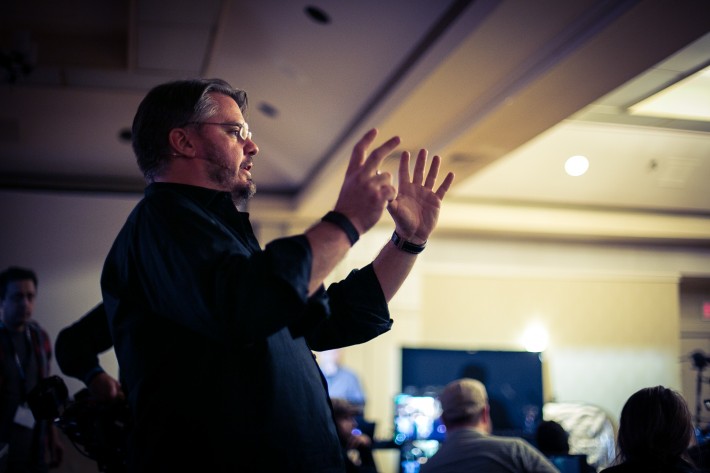
Is It Worth Going?
This workshop isn’t for everyone, but if you are looking to get into motion work from stills or just get a better understanding of the motion work you currently shoot, I’d consider it invaluable. It is basically a one day, action packed trip down the rabbit hole of camera motion and directing technique.
On a personal note, the three most critical things I took away from the workshop were:
- Better understanding of motivating the camera, using the right shot to create (and also release) tension from a shot.
- Coverage is critical, so get the shots to ensure a strong narrative can be crafted in the edit
- Motion is not just about looking for the perfect frame - that’s where motion differs from photography. Its about the movement within the frame as well as how the frame itself moves, and that the style of the camera motion should match what’s going on in the scene. There is an inherent rhythm to the craft, and getting a feel for, and understanding that rhythm is really important.
There is a clear psychology behind the craft of camera motion work, and understanding this to provide you with a more finely honed cinematic vocabulary is one of the cornerstones of what the workshop delivers. The Directing Motion Tour is traveling across the US. A full list of locations and dates can be found here. Let me know what you thought of the workshop if you attended, or drop me a line if you have any questions on it and I'll do my best to answer any queries you may have.
David Geffin | Facebook | Instagram | Twitter | Vimeo







This is an ad, not a review.
Totally agree.
Yep, came off sounding like an ad.
I did go to the workshop (day session because I had evening plans) and thought Vincent was a great teacher (easily better than he was on CreativeLive way back).
I do wish he covered m4/3 systems like the GH3/GH4/BMCC but Canon sponsors the event so it's not too surprising...
I attended this exact workshop. If you are going to attend this, get the crew seat premium package as things got packed at our NJ location.
I hate the trend today of how a lot of still photographers are now calling themselves a DP/Director with such low quality work. So in that vain, I Initially always thought of Vincent as a talented photographer whose Director/DP career has riding on the coat tails of his successfully fortunate showcase of the 5d mark 2 in Reverie. I could not have been so far from the truth. Vincent and his team effectively and efficiently go through the core workings and structure of motion by showing numerous examples employed in classic as well as modern films. Most importantly they also so show why the reasonings behind using these movements for both aesthetic and budgetary purposes. You really see how much experiences and trial and error he has gone through from the early wild west days of DSLR shooting to now shooting far larger projects.
Vincent also went spoke about his recent endeavors in the commercial world and gives you a extremely in depth look at a project from preproduction to final delivery. This information was very important to me since it can be a easily overlooked but critical make or break aspect to a project.
As for the format of the presentation it was well paced and the actual room setup was perfect. As shown above, monitors were placed at each table to show what the cameras were shooting as well as what was being presented for the rest of the keynote. The use of a movie set within the presentation was a great tool for showcasing the principles being touched upon.
At the end of the day this was by far the best workshop I have attended and easily eclipsed ones from other season professionals at a fraction of the cost. Vincent is without a doubt true professional cinematographer/Director and I cannot wait to see what new endeavors he will undertake.
I am not paid by Fstoppers or Motion Tour, these are my own opinions.
Okay, now THAT'S a review. I'm signed up for the Sacramento seminar, and can't wait.
The main post can't be considered an honest review for obvious reasons, and really feels like a bait-and-switch simply designed to drive traffic. Which sadly seems to be a real growing trend here on fstoppers.
I was also there in NJ and agree with Krishna's observations. It was well done and very informative. It is a challenge to make a seminar that educates such a wide group of talent, from people who are working film professionals to still shooters like myself who are wishing they had more of a command of the video capabilities of the gear they already own. Vincent did an amazing job of making sure both groups left with valuable knowledge.
Also one thing I would have liked however, is if Vincent would have gone into his experiences of directing his short "Mobius". However the workshop was already occupying the maximum timeframe that a day could allot so it's understandable for why this portion was excluded.
I went to the Boston workshop. I had heard nothing but good review (he'd only done two workshops in two different cities at that point though) so I was expecting great things. I was disappointed.
There WAS some good information there. I'll give him that. But unfortunately I found it very beginner level information. For instance we spent the first hour, maybe hour and a half talking about the difference between and watching examples of Pans, booms, slides, zooms, etc.
Who is this workshop for? People who don't know the difference between a pan and a zoom? Perhaps there were people at the workshop that found this helpful. I was not one of them though.
A lot of time was spent trying to replicate camera moves we saw in specific clips. We tried to replicate two from "Empire of the Sun" and two from "Schindlers List". But why? How does this help us? We are setting up the shot...in case someone doesn't know how a dolly works? Most of the "hands on" time was spent with the people who volunteered to shoot the segment trying to figure out how to use the equipment. So it ended up being about 20 minutes of people floundering around and trying to find where the controls were on the camera, dolly, follow focus etc. I did not find this useful. Perhaps other people felt differently but I would be interested to know what those people learned from that "hands on" time.
Later in the workshop he showed us how he would cover an episodic television shoot. I thought it was a complete and utter mess. Absolutely no regard for screen direction, eyeline, the 180 degree rule, etc. It was what I have heard called "dump truck shooting". Essentially you shoot every conceivable angle with multiple cameras, then repeat that same process again and again with different lenses, different camera blocking, etc. Then you take all that footage and dump it on your editor and say "ok, make something out of this". I did feel like there was any sense of how the end scene would look or how it would cut together other than, well, if we get enough coverage there's no way and editor couldn't find some way to cut this together in some sort of cohesive way. I will say though, he said this is how he would shoot episodic television. I have never been on an episodic television shoot, perhaps this is actually how it is done. But when you watch a show like "Breaking Bad" you can clearly tell a lot of thought was put into how the camera moved, where the actors were positioned, how the shots cut together, how to keep visual continuity etc. I didn't see that in the short little shoot he directed. When it was cut together and he showed it later I thought it was a mess.
At the end he went over one of his shoots from beginning to end. From the initial email pitching the idea, to how he wrote up a treatment, bid the job, planned it, did test shoots, and shot the finished spot. It was interesting, but if you've ever been involved in any kind of shoot before this probably isn't anything groundbreaking or new. It felt a little bit like a 2 hour Vincent Laforet ad.
So, that's my review. Take it for what it is worth. If you are a novice or have never been behind a camera before you may indeed find this useful! But if you have ever been on a set before, shot a short film with a small crew and modest gear, or if you have even read a good book on cinematography before you might not get too much from this workshop.
Just my two cents.
Thank-you for the honest input. I was really bummed when I couldn't attend the local workshop, but I had an underlying suspicion with these kind of things, even when they claim to be not for beginners.
Appreciate your input.
Thanks Tim. I was afraid everyone would be hating on me for my review.
I'm not trying to knock the workshop or discourage people who found useful information. I just wanted to share my experience.
Sincere question: Has Vincent ever directed episodic television?
Not certain. He showed some behind the scenes footage from Shameless and it seemed as though he may have worked on that show in some capacity. But I don't know for sure.